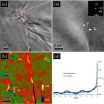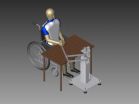(Press-News.org) The fracture of materials is a very important issue for both structural and functional materials. Crack-tip behavior is among the most basic problems in fracture mechanics. Many theoretical and experimental investigations have been carried out to understand the effect of crack-tip deformation fields. However, direct nanoscale measurement of strain fields around the crack-tip has not yet been achieved, despite many years of research. Professors Zhao ChunWang and Xing YongMing from Inner Mongolia University of Technology set out to tackle this problem. They adopted a combination of high-resolution transmission electron microscopy (HRTEM) and geometric phase analysis (GPA) and mapped the near atomic-scale strain fields of a crack-tip. Their work, entitled "Quantitative analysis of nanoscale deformation fields of a crack-tip in single-crystal silicon", was published in SCIENCE CHINA Physics, Mechanics & Astronomy. 2012, Vol. 55(6).
Although the fracture of materials is part of our everyday experience, the process is not well understood. The effects of fracture of materials are obvious on macroscopic scales, but the dynamics of fracture that lead to such failures are governed entirely by the material's behavior at the smallest scale. Deformation fields of a crack-tip were examined using HRTEM, which is becoming an increasingly powerful tool for measuring deformation fields at the nanoscale because of the development of quantitative image analysis methods. One such technique is GPA, which has been applied to a wide variety of systems, such as dislocations, quantum dots, nanowires, nanoparticles, heterostructures, low-angle grain boundaries, etc. The current work presented an HRTEM investigation of a mode II crack in single-crystal silicon. First, a micro-crack in single-crystal silicon was found using TEM under low magnification (Figure a). Second, the crack-tip was located and a higher magnification HRTEM image obtained (Figure b). Third, the GPA method was employed to map the strain fields of the crack-tip area from the HRTEM image (Figure c). Because the HRTEM images are at near atomic-scale, the strain map is also at near atomic-scale. The measurements showed that the strain at the crack tip was pure shear strain, and thus the micro-crack was identified as a mode II crack. Finally, the experimental strain values on the crack plane were extracted and compared with theoretical predictions from linear elastic fracture mechanics (Figure d). The comparison shows that the experimental results on the crack plane agree with the theoretical predictions up to 1 nm from the crack-tip.
Until now, experimental research on micro-cracks has mainly focused on initiation, extension and morphology at a wide variety of scales. Professor Zhao ChunWang and his group have pioneered quantitative analysis of nanoscale deformation fields of crack-tips and developed an effective method to analyze the deformation of crack-tips at a very small scale. With further development of HRTEM, measurement and analysis of deformation fields at the atomic scale will become possible. Atomic bonding and atom movement ahead of the crack-tip may be also analyzed quantitatively.
This is an important development in the recent history of fracture mechanics. The researchers suggest that the next steps in their work are to examine more materials and also to attempt to measure the deformation fields of a dynamic crack-tip. These future efforts will be an important boost to fracture mechanics and materials physics.
INFORMATION:
This research project was partially supported by a grant from the National Natural Science Foundation of China, the Program for New Century Excellent Talents in University, and the Natural Science Foundation of Inner Mongolia.
See the article: Zhao C W, Xing Y M. Quantitative analysis of nanoscale deformation fields of a crack-tip in single-crystal silicon. SCIENCE CHINA - Phys Mech Astron, 2012, 55(6):1088
Near atomic-scale deformation fields of a crack-tip were mapped experimentally at IMUT
2012-10-09
ELSE PRESS RELEASES FROM THIS DATE:
Language learning makes the brain grow
2012-10-09
At the Swedish Armed Forces Interpreter Academy in the city of Uppsala, young people with a flair for languages go from having no knowledge of a language such as Arabic, Russian or Dari to speaking it fluently in the space of 13 months. From morning to evening, weekdays and weekends, the recruits study at a pace unlike on any other language course.
As a control group, the researchers used medicine and cognitive science students at Umeå University – students who also study hard, but not languages. Both groups were given MRI scans before and after a three-month period of ...
Power in the palm of your hands
2012-10-09
Forget the TV remote and the games controller, now you can control anything from your mobile phone to the television with just a wave of your hand.
Researchers at Newcastle University and Microsoft Research Cambridge (MSR) have developed a sensor the size of a wrist-watch which tracks the 3-D movement of the hand and allows the user to remotely control any device.
Mapping finger movement and orientation, it gives the user remote control anytime, anywhere – even allowing you to answer your phone while it's still in your pocket and you're walking down the street.
Being ...
Catalytic converters like it hot
2012-10-09
This press release is available in German. Catalytic converters work poorly if they have not yet warmed up. Tiny metal particles in a catalytic converter require a minimum temperature to function efficiently. At the Vienna University of Technology, thanks to a new measuring method, it has now become possible to examine many different types of these particles at the same time. Reliable information regarding what it is exactly that the efficiency of catalytic converters depends on has thus been obtained for the first time.
Low ignition temperature desired
"A large part ...
Digital tabletop system with views on demand
2012-10-09
A tabletop system where users can come together and view shared content will be unveiled today [Tuesday 9 October]. A team of scientists, led by the University of Bristol, have developed the system aimed at supporting mixed-focus collaborative tasks.
Researchers from the University's Department of Computer Science will present PiVOT (personalised view-overlays for tabletops) at the 25th ACM UIST 2012, a symposium for innovations in the software and technology of human-computer interfaces.
Through two view zones, PiVOT provides personalised views to individual users ...
Scientists develop a blood test that detects aggressive prostate cancers
2012-10-09
Scientists from the Spanish National Cancer Research Centre (CNIO) in Madrid, along with British colleagues from the Institute for Cancer Research (ICR) and the Royal Marsden NHS Foundation Trust, have developed a test that studies genetic patterns in blood cells to detect advanced–stage prostate cancer. The results of the study are being published today in the journal The Lancet Oncology.
The study shows that gene patterns in blood cells act as a barcode and could be used together with the current PSA test to select those patients with the worst prognosis in need of ...
Liquorice offers clue to cleaner medical implants
2012-10-09
Oxford, October 8, 2012 - A nanotech material containing an extract from liquorice can be used to sterilize and protect medical devices and implants which include biological components, and protects these functional bio-components during the sterilization process.
Publishing their findings in the latest issue of Materials Today, a team of researchers from Germany and Austria explain how conventional sterilization techniques based on a blast of radiation, or exposure to toxic gas can damage the functional biological components of the device. The coating, containing a component ...
New methods might drastically reduce the costs of investigating polluted sites
2012-10-09
This press release is available in German.Ferrara/Leipzig. New methods might allow polluted sites to be investigated and monitored long term at significantly reduced costs. Authorities and those who have to remediate polluted sites in Europe might therefore be able to save costs and use these to treat other areas. This is the conclusion of the EU research project ModelPROBE, which was coordinated by the UFZ. The results, with which the scientists aimed to lower the workload of authorities and consultants, include a handbook detailing the methods for characterising contaminated ...
Worldwide patent for a Spanish stroke rehabilitation robot
2012-10-09
VIDEO:
This is about the worldwide patent for a Spanish stroke rehabilitation robot.
Click here for more information.
Robotherapist 3D, a robot which aids stroke patients' recovery, is to be brought to market by its worldwide patent holder, a spin-off company from the Miguel Hernández University of Elche (Alicante, Spain). It is the first robot to enable patients to start doing exercises while supine, allowing them to begin shortly after the stroke and expediting recovery. ...
River Thames invaded with foreign species
2012-10-09
Almost 100 freshwater species not native to the UK have invaded the River Thames catchment making it one of the most highly invaded freshwater systems in the world, according to scientists at Queen Mary, University of London.
The research, published in the journal Biological Invasions at the weekend, suggests that legislation to prevent the introduction of non-native species across the UK has been unsuccessful. The cost to the British economy of invasive non-native species is £1.7bn every year (CABI report, 2010).
Lead author, Dr Michelle Jackson* who undertook the ...
VIB concludes that Séralini study is not substantiated
2012-10-09
The scientific analysis in this document shows that the research design of Séralini et al. contained fundamental shortcomings that preclude any sensible conclusions from being drawn. In other words, the statements that Séralini made about the health effects of GMOs and Roundup were baseless. Moreover, the research shows signs of selective interpretation of the findings or a misleading representation of these, which is contrary to prevailing scientific ethical standards.
###View the entire analysis online: http://www.vib.be/en/news/Pages/VIB-concludes-that-Seralini-study-is-not-substantiated-.aspx
...


